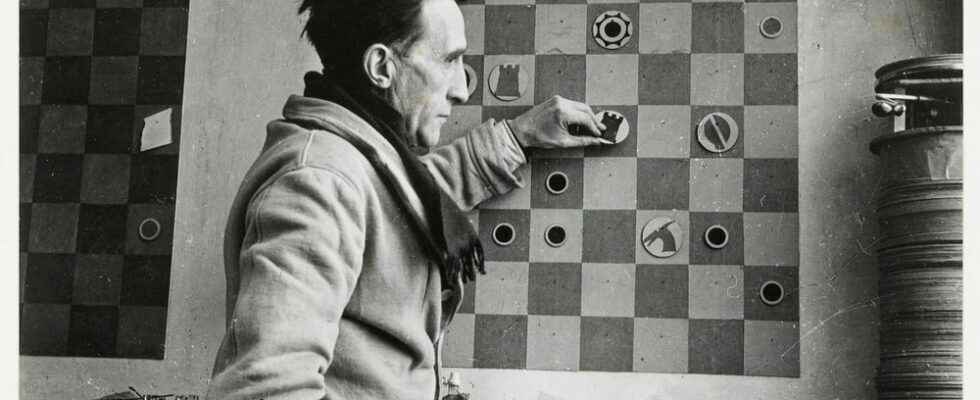Exhibition
Marcel Duchamp
MMK, Frankfurt. Shown until 3/10
Show more
It may seem as if Marcel Duchamp for long periods avoided creating art and instead devoted himself to other things: wordplay, chess, gambling, art trade, party fixing. A lot of time also seems to have been spent courting wealthy women. Today he would have been called an art advisor. He partly supported himself by mediating the sculptor Brancusi’s work in the United States.
Duchamp wanted to create the image of himself as lazy. But when I walk around in the giant retrospective on display at the Museum für moderne kunst (MMK) in Frankfurt, I am struck by the amount of work.
The entire museum has been emptied so that Duchamp’s works can take over all the halls. Many of them appear in different versions, some hang in the air and cast interesting shadows (sometimes painted there).
I’m amazed how many objects I have actually never seen before. In fact, Duchamp seems to have worked non-stop, and everything is documented so that the logic becomes visible in retrospect. It is as if he created for us today, for posterity.
That the museum has been emptied of all other artists’ works feels both daring and necessary. Now all the intricate connections between the works can emerge. Maybe everything is a single work?
Should the art world never get tired of Duchamp?
He was already mentioned in Guillaume Apollinaire’s “The Cubist Painters” in 1913 and was then active in the immediate vicinity of Dadaism and Surrealism.
Strangely enough, he then plays a key role throughout the century: concept art would be unthinkable without him. Both pop art and minimalism found aspects of his work that they could develop. When postmodernism in the 1980s came to question the idea of the original, Duchamp was again the forerunner.
Among Duchamp’s obscure notes on the fourth dimension, one now also finds thoughts about the virtual, which has led enthusiasts to see his central work “The Big Glass” (1915-21) as a prophetic object that anticipates digital possibilities. And the most ambitious attempts to theorize the art of NFT, the unique digital objects made possible by blockchain technology today, again take hold against Duchamp’s ideas of “ready-mades”.
No, we will not get rid of with him.
I have heard the French point out that Marcel Duchamp’s petty jokes are not as profound as foreign art critics have imagined. On one level, they are just expressions of student food jokes. And yet the most extensive interpretations of his works have relied on everything from mysticism and alchemy, to psychoanalysis and non-Euclidean geometry to grasp the insidiously elusive works.
Psychoanalyst Jacques Lacan claims somewhere that the analysis has come to an end when the patient understands that it will last forever. Possibly it is such an infinite analysis that Duchamp’s work draws the viewer into. Each layer of meaning seems to obscure another level.
After a short career as a painter, he left already in the 1910s what has traditionally been art’s most prestigious medium. The very notion of creating a work of art became somewhat problematic. “Can you do something that is not art?” was the artist’s new question.
His answer is: readymaden. Duchamp selects certain everyday items – a bicycle wheel, a bottle dryer, a urinal – and exhibits them as if they were works of art. He does not actively charge them with depth and meaning, but stays dry. Or as Duchamp says: indifferent. He has not created these objects, they are already made, but something happens to them when they are pulled out of their use contexts and become a kind of object for contemplation. Have they turned into art?
The very provocation that lies in sending a urinal as a contribution to an art exhibition can of course have a value in itself. But for Duchamp, it is not just a Dadaist gesture, but something bigger: a transformation of the very notion of creation. Stupid as a painter, it is said in France. The turpentine fumes were nothing for the oververbal chess genius Duchamp. He criticized the painting for being “olfactory” (linked to the smell) and “retinal” (too dependent on vision), and suggested that the gray cells (brain) be activated.
His new medium became language and the enigmatic relations of words to things and to themselves. His objects are always linked to strange titles that turn them into a kind of concrete poem.
A Duchamp retrospective can only be done if you collaborate with the museum in Philadelphia, with the Museum of Modern Art in Stockholm or with the Tate Gallery in London. Only these institutions have versions of his magnum opus, the large stained glass “The Bride Undressed by His Bachelors, Empty”. In Frankfurt, the London version is shown.
The transparent object is a kind of self-portrait. In the “Green Box”, a collection of notes with comments, Duchamp calls the upper part “MAR” and the lower part “CEL”. The own name is so inscribed in the title of the work: MAR i mariée (the bride) and CEL i célibataire (bachelor). Yes that’s how it is. But what’s the point? Duchamp liked traps and if you start to ponder it too much, you are stuck in the snares. Some never get loose again.
Read more about art
